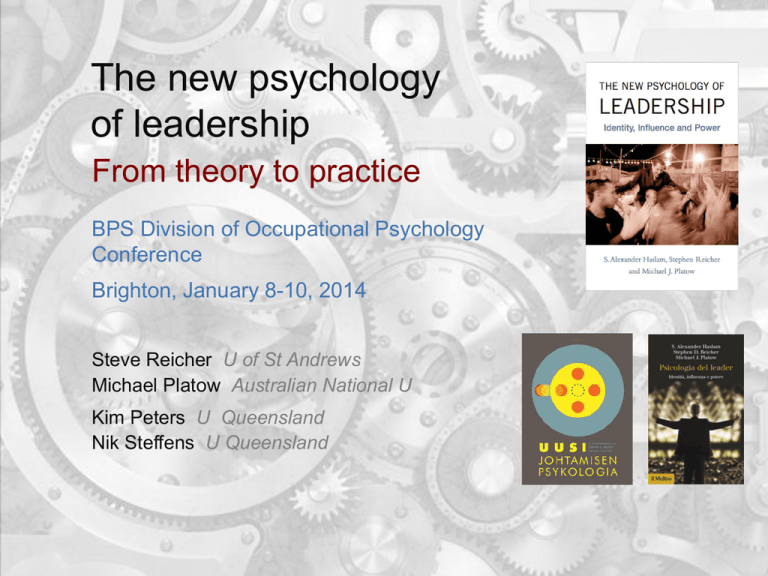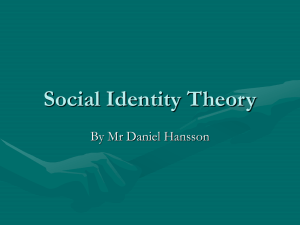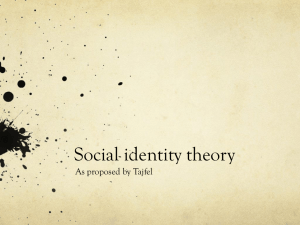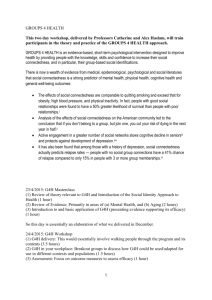New Psychology of Leadership: Social Identity Approach
advertisement

The new psychology of leadership From theory to practice BPS Division of Occupational Psychology Conference Brighton, January 8-10, 2014 Steve Reicher U of St Andrews Michael Platow Australian National U Kim Peters U Queensland Nik Steffens U Queensland What is leadership? The process whereby one or more members of a group influence other group members in a way that motivates them to contribute to the achievement of group goals (Haslam, 2004; Smith, 1995; Rost, 2008) It’s not just about leaders, it’s about followers It’s not about me, it’s about us (i.e., it’s a group process) It’s not about power over, it’s about power through (Turner, 2005) 2 Old and current psychologies of leadership • Trait-based: effective leaders are simply “great men” (Plato, 380bc) • Contingency: effective leadership is a product of a ‘perfect match’ between personality and context (Fiedler, 1964) • Behavioural: effective leaders display ‘initiation of structure’ and ‘consideration’ (Fleishman & Peters, 1962) • Transactional: effective leadership is a process of social exchange (Hollander, 1978) • Transformational: effective leadership is the product of a leader’s charismatic influence What we’ve learned Leaders have skills Context matters Leaders do things Followers matter Leaders inspire (Burns, 1978) 3 Limitations of old and current psychologies of leadership • Aperspectival (leadership is rarely recognised consensually) • Inflexible (leader’s character/ style is seen as fixed and inflexible) • Individualistic (emphasis is on ‘I-ness’ rather than ‘we-ness’) The least important word in the leader’s vocabulary? ‘ I’ The most important word in the leader’s vocabulary? ‘We’ (Adair, 1991) • Non-predictive “Unfortunately, in real time, it is unclear who will be known as visionaries and who will be known as failures” (Nadler & Tushman, 1990) • Qualitatively lacking (fails to explain, the‘something more’of leadership) 4 The new psychology of leadership The social identity approach Tajfel & Turner, 1979; Turner et al., 1987, 1994 Haslam, 2001 • Takes the psychological reality of the group (‘we-ness’ or social identity) as its starting point. • People can (and often do) define themselves in terms of social identity (‘us psychologists’, ‘us members of team X’, etc.) not just personal identity (‘I’). • People are motivated to have a positive and distinct self-concept. • When their sense of self is defined in terms of social identity, they want to see their in-group as positive and distinct from out-groups — we want ‘us’ to be special. 5 The new psychology of leadership The social identity approach Why does social identity matter so much? social identity communication trust engagement well-being Social identity makes organization possible (Haslam et al., BJM, 2003) 6 Leadership as social identity management • These points are also highly relevant to leadership because • A leader can be seen as someone who embodies (is prototypical of) a social identity that is shared with other group members — and who exerts influence on this basis. • Leadership can be seen as a process of social identity management that centres on a leader’s ability to create, represent, advance and embed a shared, special sense of ‘us’. • Indeed, without social identity there can be no leadership: we can only be led if there is a ‘we’ to lead. • These ideas can be unpacked in terms of 4 key elements of leadership …. Being one of us Doing it for us Crafting a sense of us Making us matter 7 1. Being one of us Leaders as ingroup prototypes • Leaders are more effective (more likely to be influential) the more they are perceived to represent a social identity that we share. • They need to be seen as ‘one of us’ (not ‘one of them’) and as embodying ‘who we are’ and ‘what we want to be’. We are influenced by our leaders … … Not theirs. 8 1. Being one of us Leaders as ingroup prototypes • Leaders are more effective (more likely to be influential) the more they are perceived to represent a social identity that we share. • They need to be seen as ‘one of us’ (not ‘one of them’) and as embodying ‘who we are’ and ‘what we want to be’. Study of all official Australian election speeches since Federation in 1901 (Steffens & Haslam, PLoS ONE 2013) Winners use ‘we’ once every 79 words Losers use ‘we’ once every 136 words 250 Uses of 'we' per speech Successful Leader Unsuccessful Leader 200 150 100 50 0 9 1. Being one of us Leaders as ingroup prototypes • Leaders are more effective (more likely to be influential) the more they are perceived to represent a social identity that we share. • They need to be seen as ‘one of us’ (not ‘one of them’) and as embodying ‘who we are’ and ‘what we want to be’. • Things that set (or are perceived to set) leaders apart from the group can undermine the effectiveness of their leadership. • Evidence from Sherif (SA, 1956). Winners … Losers … Leaders of the losing group are set apart from rank-and-file members 10 2. Doing it for us Leaders as ingroup champions • Leaders are more effective (more likely to engender creative followership) the more they are perceived to stand up for a social identity that we share. • Their leadership will be compromised if they place out-group or personal interests above those of the in-group (Blanning, 2003; Dening 2002) Sovereignty resides in my person alone and my courts derive their existence and their authority from me alone. They exercise it only in my name and it may never be turned against me. I come before the group Of myself I must say this, I never was any greedy scraping grasper, nor yet a waster, my heart was never set on worldly goods, but only for my subjects’ good… And though you have had and may have many mightier and wiser princes sitting in this seat, yet you never had nor shall have any that will love you better. The group comes before me 11 2. Doing it for us Leaders as ingroup champions • Leaders are more effective (more likely to engender creative followership) the more they are perceived to stand up for a social identity that we share. • Their leadership will be compromised if they place out-group or personal interests above those of the in-group. Other leaders don’t generate much creativity, and it’s the wrong sort Only a pro-ingroup leader generates helpful forms of creativity Haslam & Platow, PSPB (2002) 1.2 Study in which Ps asked to generate ideas to back up 0.8 leader’s ideas when leader No of has previously been either followers’ 0.4 ideas (a) pro-ingroup (b) even-handed 0 (c) pro-outgroup positive ideas pro ingroup negative ideas L even-handed pro outgroup Leader's behaviour 12 3. Crafting a sense of us Leaders as entrepreneurs of identity (Chapter 6) • Successful leaders craft identity to ensure that they (and their vision) are prototypical for the group. • This involves sensitivity to the way they appear to in-group members. Leaders advance by casting themselves in the image of the group to be led … and fail if they don’t (or can’t) 13 4. Making us matter Leaders as embedders of identity (Chapter 7) • Successful leaders are identity impresarios who initiate identityembedding structure (e.g., goals, activities, practices). Leadership is sustained by leaders who devise structures that embed, maintain and promote that sense of ‘us’, and who assume authority on that basis Leadership and power arise from identity not resources 14 4. Making us matter Leaders as embedders of identity (Chapter 7) • Successful leaders are identity impresarios who initiate identityembedding structure (e.g., goals, activities, practices). • This ensures that the rhetoric of ‘us’ is translated into lived experience and material reality. Leadership is sustained by leaders who devise structures that embed, maintain and promote that sense of ‘us’, and who assume authority on that basis The key social achievement of [Paul’s] communityforming actions [consisted] in the bringing together of many people into one body, the construction of a new form of corporate solidarity … that transcend[ed] former distinctions. (Horrell, 2005) 15 Leadership as Identity Management • Research confirms the fundamental point that leadership is about social identity management. • This identity leadership has four key elements: C identity entrepreneurship C Creating us identity embodiment RRepresenting us A R E identity promotion identity impresarioship AAdvancing us EEmbedding us To do leadership you need to CARE — and be seen to CARE — about the group 16 The New Practice of Leadership Prevailing approaches tend to be.... NPoL suggests they need to be .... • Individual-oriented • Focused on benefits to individuals • Group-oriented • Focused on benefits to groups • Conducted apart from followers • Follower-excluding, distanceenhancing • Conducted together with followers • Follower-involving, distancereducing • Romanticized (hubris-inducing) • Abstracted (leading by thinking) • Off-the-peg • Grounded • Practical (leading by doing) • Organization- and context-specific • Non-evidential (“happy sheets for leaders”) • Evidence-based (demonstrating +ve impact on followers and the group) 17 The New Practice of Leadership Three key practical challenges of leadership and identity management 1. How can leaders engage with a diverse workforce (where all groups make a unique contribution to the organization)? 2. How can leaders attend to the goals and aspirations of diverse subgroups (e.g., to respond to diverse group needs)? 3. How can leaders integrate the needs of diverse sub-groups into coherent strategy and policy? Our answers to these question build on the ASPIRe model (Haslam et al., JOOP, 2003; Peters et al., GOM, 2013) and translate them into a programme of Leadership and Identity Development Activity (LIDA; Peters et al., 2013) 18 The New Practice of Leadership To address these 3 questions, LIDA takes leaders through a three-stage process in which they work with team members to: 1. Discover what social identities matter to people. AIRing Reflecting 2. Discover the goals and aspirations associated with different SubCasing Workshop Representing identities and facilitate activities that help achieve them. 2 3. Define and integrate different identity-related goals and embed them in overarching practices and policies. SuperCasin g ORGanizin g Our current work is refining and road-testing a range of tools to support each of these activities (Peters et al., 2014) Realizing The 3 R’s of Identity Leadership 19 The New Assessment of Leadership Identity Leadership Inventory (ILI; Steffens et al., LQ, in press) C Identity Entrepreneurship: Creating a shared sense of ‘us’ • This leader makes people feel as if they are part of the same group. • This leader creates a sense of cohesion within [the group]. • This leader develops an understanding of what it means to be a member of [the group]. • This leader shapes members’ perceptions of [the group’s] values and ideals. R A Identity Prototypicality: Representing a shared sense of ‘us’ • This leader embodies what [the group] stands for. • This leader is representative of members of [the group]. • This leader is a model member of [the group]. • This leader exemplifies what it means to be a member of [the group]. Identity Advancement: Advancing a shared sense of ‘us’ • This leader promotes the interests of members of [the group]. • This leader acts as a champion for [the group]. • This leader stands up for [the group]. • When this leader acts, he or she has [the group’s] interests at heart. E 4 studies in USA, China and Belgium demonstrate: • Construct validity • Discriminant validity • Criterion validity Identity Impresarioship: Embedding a shared sense of ‘us’ • This leader devises activities that bring [the group] together. • This leader arranges events that help [the group] function effectively. • This leader creates structures that are useful for [group members]. • Content validity (dimensions capture meaningful constructs) (dimensions are distinct) (distinguished from other leadership constructs) (predicts key leadership 20 outcomes) The New Assessment of Leadership ILI used in LIDA to assess 4 components of Identity Leadership from the perspective of both Leaders and other Group members (followers) both pre- and post- intervention Creating ‘us’ C10 A 10 Advancing ‘us’ 0 • Leaders pre-LIDA • Group members pre-LIDA • Leaders post-LIDA • Group members post-LIDA R 10 Representing ‘us’ The CARE square Leadership (and LIDA) involves trying to enlarge the CARE square — and whether it does is something we can assess Embedding ‘us’ 10 E 21 A new politics of leadership • To understand, and properly do, leadership we need to move beyond the individualistic and hubristic models that have dominated the field to date. • Leadership is a we-thing, not an I-thing — and so is its psychology. Learning to lead is about learning (how) to CARE about all the groups for which we have responsibility • Occupational Psychologists have a major role to play in turning thinking, and practice, around. • Let’s do it — if we’re serious about investing in all our futures, it’s time. 22











